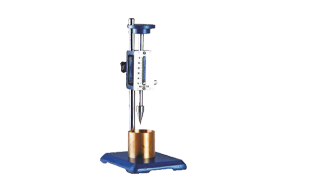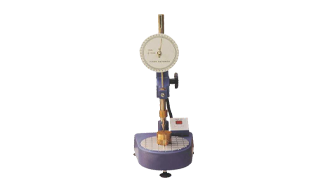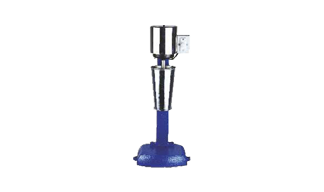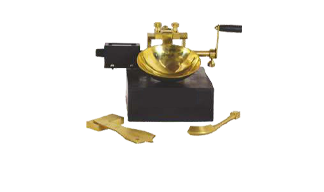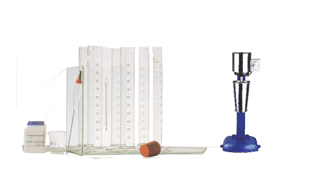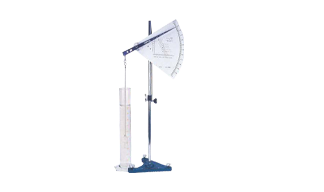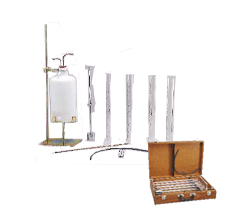Plastic Limit Set
Specification:
The complete set consists of one each :
1. Glass plate 20cm x 15cm having round ends
2. Brass or stainless steel rod 3mm dia x 150mm long
3. Flexible spatula 15 cm
4. Set of 6 moisture containers
5. Porcelain basin 150mm dia
6. Plastic wash bottle 500ml
Shrinkage Limit Set
Specification:
Set consists of one each:
Porcelain evaporating dish
Shrinkage dish
Glass cup
Perspex plate with three metal prongs
Flexible spatula 100mm
Linear Shrinkage Mould
Specification:
A simple mould which is filled with the soil under test.
This is then dried and the resulting decrease os length of
the specimen measured is expressed as the linear
shrinkage. It is 25mm Dia. x 12.5mm Height x 140mm
Length.
Soil Cone Penetrometer
Specification:
For determining the liquid limit of soils. This is specially
useful to obtain reliable and accurate results of those soil
which have low plasticity index. The percentage
moisture contents determined when cone with half angle
of 15-30 minutes under a total sliding weight of 148 gm
penetrates 25mm gives the liquid limit.
Semi Automatic Cone Penetrometer
Specification:
Used to determine the moisture content at which clay soils pass from a
plastic to a liquid state. Two Version are available. One the standard one
& the other is semi-automatic with timer where the cone is allowed to free
fall for a period of 5 seconds including one each of 50 gm. & 100 gm.
weight, one penetration cone, preset counter & measuring cup.
High Speed Stirrer
Specification:
This is for mechanical analysis and also other laboratory
applications for stirring Speed approximately 4000 R.P.M. under
load. A dispersion cup is supported on a rest on the stand of the
stirrer and has a removable baffle. For operation on 230V A.C.
supplied with dispersion cup or baffle cup.
Soil Hydrometer
Specification:
Used for grain size analysis of soils where more than 10% of the material
will pass through 75 microns B.S. sieve. Manufactured from clear
transparent glass having uniform clarity throughout the upper end on which
density scale is engraved. The scale range is 0.995 to 1.030 density
(gms./cc) at 270C smallest division on the scale is 0.0005
Liquid Limit Device With Counter
Specification:
Casagrande method in mechanical form is known as liquid limit method and has been in use for soil mechanics for a
number of decades. The liquid limit data of soils is useful to correlate mechanical properties of soil, such as
compressibility and lower shear strength. Liquid limit is the water content at which soil passes from zero strength to an
infinite strength, hence the true value of liquid limit cannot be determined.
For determination purpose liquid limit is that water content at which a part
of soil, cut by a groove of standard dimensions, will flow together for a
distance of 1.25cm under an impact of 25 blows in a standard liquid limit
apparatus. The soil at the water content has some strength which is about
0.17N/cm. sq. (17gms/sq.cm.) . At this water content soil just passes
from liquid state to plastic state.
It consists on a brass cup held on an adjustable bracket.
The cup can be adjusted for a fall of 1 cm and can be raised an dropped
on a rubber base of standard hardness by cam action. Complete with one
Casagrande grooving tool, one ASTM grooving tool and a height gauge
block. A counter to register the number of blows
Grain Size Analysis (Pipette Method)
Specification:
This is for the determination of the sub sieve particle distribution in a
soil sample by mechanical analysis. An analysis of this kind
expresses quantity the proportions by weight of the various sizes of
particles present in the soil. It is recommended as a standard
procedure to use dispersion agent to avoid flocculation.
The apparatus consists of a sliding panel which moves up and
down by means of a screw allowing Anderson pipette fixed to it to
be raised or lowered vertically. A sedimentation tube is held by a
laboratory clamp provided on the stand below the pipette. The
depth of immersion is measured by a scale graduated in mm at the
side of the sliding panel. Supplied complete with Anderson pipette
10ml. At the side capacity made from glass, and a sedimentation
tube also of glass of 500ml capacity and 50nos. Test form pads.
Particle Size Sedimentation (Hydrometer Method)
Specification:
Particle size analysis of soils:
Hydrometer method
This equipment is used to determine the quantitative
size distribution of very fine particle in soils such as clay and silt.
Plummet Balance
Specification:
Conventionally particle size distribution analysis is carried out using pipette and
hydrometer methods. Whereas in hydrometer method it is possible to determine
particle sizes in the range 75microns, the method involves computation and it is
time consuming. The pipette method can be used for determining only the
percentage of specific sizes less than 0.02, 0.006 and 0.002mm as a percentage
of total soil sample.
The plummet balance method to determine sub sieve particle size for the entire
range is very rapid and only manipulation of height of the balance, so that plummet
sinks to the right depth is required.
The percentage of soil in suspension is directly indicated by a pointer over a
graduated scale.
A vertical rod is mounted on a sturdy base having leveling screws.
A pointer with steel pivots turns is jewel bearing an moves over a graduated scale.
Scale graduations are market 0-100% x 2%.
To the other end of the pointer a plummet is hanged. Rack and pinion arrangement is provided on the vertical rod for
adjusting the height. Supplied with a chart showing relationship between “K” and temperature of suspension of
soils of varying specific gravity from 2.4 to 2.8 to help in solving stroke's equation. Supplied complete with one
Perspex plummet one measuring jar and one rider weight for zero adjustment and rider weight for adjusting the
pointer to 100%.
Sand Equivalent Test Set
Specification:
Used to determine the relevant proportions of clay-like or Plastic
fines and dust in granular soils & fine aggregate
Consists of:
Acrylic graduated cylinder (4 nos.)
Rubber stopper for cylinder (4 nos.)
Graduated Steel rule 450 mm
Funnel 100 mm plastic
Aspirator bottle 5 lts plastic with rubber cock
Stand for the aspirator bottle with siphon assembly
Irrgation tube with stop pinch cock & weighted foot assembly



